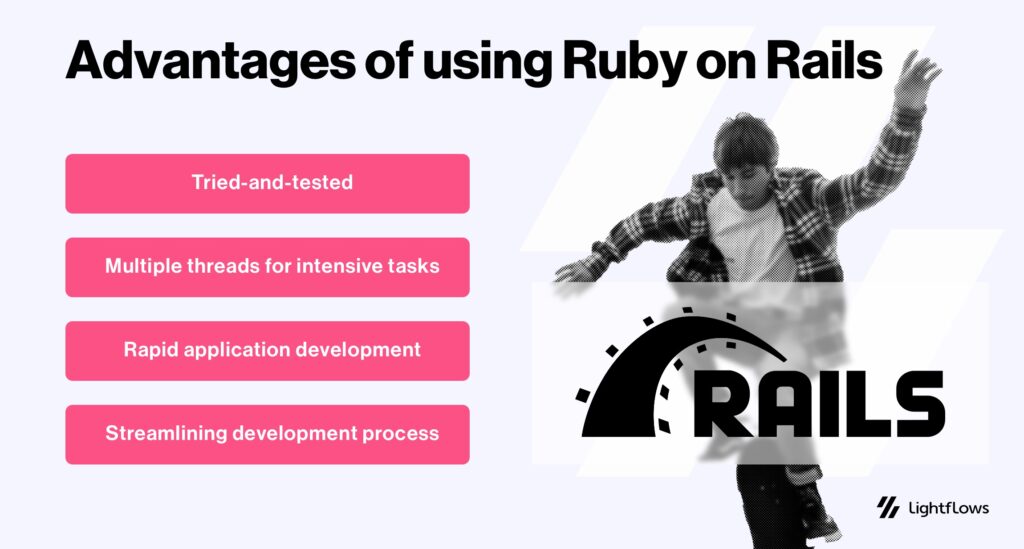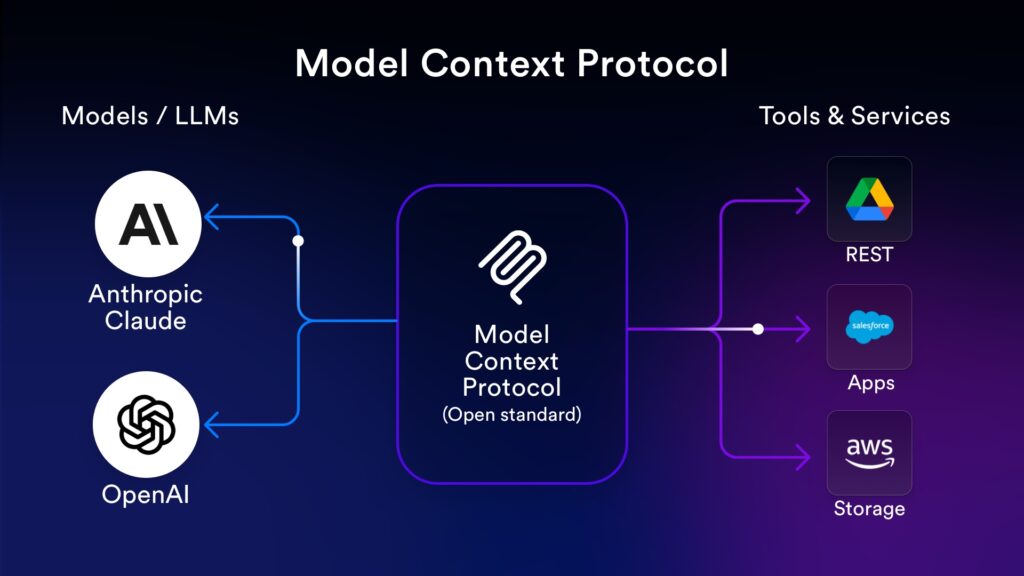When it comes to backend frameworks and technologies, it can feel like you’re spoiled for choice. In this article, we’ll compare Node.js vs Ruby on Rails – two names that stand out as key backend technology options for startups and established businesses alike.
Let’s start with a quick clarification. Node is a JavaScript runtime environment rather than a standalone programming language. Node works by transforming JavaScript into machine code to enable server-side coding. In contrast, Ruby on Rails is a framework built on the Ruby programming language, known for its quick processing and effective coding. There are numerous frameworks for Node as well, though, such as ExpressJS.
The popularity of both Node.js and Ruby on Rails as backend frameworks has surged in recent years. In this article, we’ll delve into the advantages of both options, exploring how they’re used in various industries and scrutinising their primary technical characteristics.
Curious about what sets Node.js and Ruby on Rails apart? Read on to find out more.
What is Node.js?
Node.js functions as a JavaScript code execution environment, relying on Chrome V8 — an engine that translates JavaScript calls into machine code. Node is therefore a running environment for the JavaScript language.
Node.js made its debut in 2009, courtesy of American developer Ryan Dahl, who crafted the Node.js platform. Dahl’s novel platform prioritises events, which means Node applications are fast to start and easy to use. Node developers can build backend and frontend with a single unified stack, allowing the construction of scalable network servers.
Companies that use Node.js
If Node’s so great, who’s using it? Some of the world’s most well-known companies depend on Node for their success. First up, Netflix. With nearly 250 million paid subscribers, Netflix uses Node for high-volume web streaming and content production. Those numbers are hard to argue with!
Similarly, industry giant Uber chose to develop its core trip execution engine in Node.js. Imagine the complexity and scale of Uber’s backend, reliably connecting drivers and customers around the world at the touch of a button. Node’s asynchronous and single-threaded processing allowed for this scalable functionality.
And that’s not all. PayPal opted for Node.js for its web application development, while NASA uses Node.js to migrate its data to cloud storage and improve database access speeds.
Pros and cons of Node.js

Of course, there is no such thing as a perfect backend technology. In this section, we’ll explore the pros and cons of Node.js.
Pros of Node.js
- Fast delivery: Node.js is renowned for its speed and efficiency in handling operations, thanks to its non-blocking, event-driven architecture. With fast data processing and quick response times, it’s well suited for applications requiring real-time updates, such as chat apps and streaming services.
- Scalability: Node.js applications can handle a lot of simultaneous connections without compromising performance. Its event-driven model, coupled with the ability to handle asynchronous operations, makes it ideal for building scalable network applications.
- Cross-platform support: Node applications can run on various operating systems, including Windows, macOS and Linux. This simplifies the development process and ensures applications are easily deployable across different environments, contributing to a more seamless user experience.
- Community support: Node’s vibrant and action developer community shares knowledge, best practices and a wealth of open-source modules through the Node Package Manager (NPM). This collaborative environment fosters innovation and helps developers address challenges effectively.
- Ease of adoption: Developers with JavaScript skills can seamlessly transition to server-side development using Node.js, reducing the learning curve. Additionally, the availability of a vast ecosystem of libraries and modules through NPM further simplifies the development process.
Cons of Node.js
We’ve all got weaknesses, but Node probably has fewer than most. The list below mostly concerns the Node’s limitations rather than its inherent flaws.
- Single-threaded nature: Node.js is single-threaded, using an event-driven, non-blocking model. While this works well for certain applications, it can become a limitation for CPU-intensive tasks. Operations that are computationally intensive may block the event loop, leading to performance issues.
- ‘Callback hell’: The asynchronous nature of Node.js can sometimes result in nested callback functions, commonly known as “callback hell” or “callback pyramids”. This can make the code harder to read and maintain, as well as potentially introduce errors if not managed properly.
- Limited standard library: Compared to other server-side technologies, Node.js has a relatively small standard library. Developers often rely on external libraries and modules from the Node Package Manager (NPM) to access additional functionalities. While NPM is extensive, it can lead to dependency management challenges and concerns about the security of third-party packages.
- Learning curve for asynchronous programming: Developers who are new to asynchronous programming paradigms may find there’s a steep learning curve when working with Node.js. Managing callbacks, handling errors in asynchronous code and understanding event-driven programming concepts can be challenging for those accustomed to synchronous programming.
When is it preferable to use Node.js?
As a versatile runtime environment for executing Javascript, there are certain scenarios for which Node.js is the perfect choice.
Real-time apps
Node.js is well-suited for real-time applications like chat applications, online gaming and collaborative tools. Its event-driven, non-blocking I/O processing model makes it efficient for handling simultaneous requests.
Server-side development
Node.js excels in server-side development, managing concurrent requests with its V8 engine and non-blocking I/O. Again, this makes it suitable for real-time applications, its long-polling approach ensuring dependable connections. Leveraging JavaScript on both front and backends streamlines development, promoting code reuse and enhancing overall developer efficiency.
API development
Node.js is used to create APIs for RESTful architectures, bolstering scalability and interoperability. REST APIs play a pivotal role as bridges, linking user input to an application’s underlying code. By employing Node.js for API development, developers harness its asynchronous capabilities, ensuring efficient communication between clients and servers. The stateless nature of REST simplifies interaction management, while the uniformity of its design principles fosters consistency.
Microservices
In a microservices architecture, Node.js effectively services and handles concurrent requests due to its non-blocking request processing and event-driven methodology. This enables good communication, enhancing scalability and responsiveness. On the other hand, Ruby on Rails – traditionally used for monolithic designs – can still manage microservices, as demonstrated by Airbnb’s case, by facilitating modular development and flexible releases. Both Node.js and Ruby on Rails offer unique strengths, providing developers with versatile options when designing and implementing microservices architectures, allowing them to choose tools that align with specific project needs and team expertise.
What is Ruby on Rails?
Ruby on Rails, fondly known as ‘Rails’, is an open-source web application framework written in the Ruby programming language.
Conceived to favour “convention over configuration”, Rails follows a set of conventions that streamline development, promoting code simplicity and maintainability. Released in 2004, Rails has since gained popularity for its elegant syntax, developer-friendly features and emphasis on the Model-View-Controller (MVC) architectural pattern.
Rails simplifies common web development tasks, such as database interactions and routing, through built-in conventions. It’s known for scalable, maintainable web applications and it has been used to develop numerous successful projects and startups.
Companies that use Ruby on Rails
Ruby on Rails was initially created by 37Signals, the creators of Basecamp, which is a project management and team collaboration tool. Today, some of the most well-known companies in the world are built on Rails and thriving as a result.
Ever heard of Airbnb? This globally game-changing one-stop-shop for lodging and travel experiences uses Rails for its platform, benefiting from the framework’s flexibility and scalability to handle a vast array of property listings and user interactions.
GitHub is built on Rails. As the world’s most popular platform for version control and collaborative software development, Rails provides a user-friendly experience for developers to host, review and collaborate on code repositories.
The accolades go on… Shopify, a massively popular e-commerce platform that helps businesses set up online stores, relies on Rails to deliver a customisable solution. Millions of merchants are making money by managing their online businesses through this Rails-powered platform. Fiverr provides another compelling use case. This online marketplace connects freelancers with clients via a dynamic platform that facilitates the buying and selling of services across diverse categories.
Ruby on Rails: Pros and cons

Rails has passed the ultimate test: time. Here, we’ll look at the pros and cons of this versatile and reliable backend technology.
Pros of Ruby on Rails
- Tried-and-tested: Ruby on Rails has a proven track record dating back to 2004. Its longevity speaks to its reliability and stability. The framework benefits from a mature ecosystem with solid packages and a robust package management system, ensuring developers have access to high-quality third-party code. This stability is a real win when it comes to building scalable and maintainable web applications.
- Multiple threads for CPU-intensive tasks: Because Ruby on Rails supports the use of multiple threads, it’s well-suited for handling CPU-intensive tasks.
- Rapid application development: Ruby on Rails is known for its rapid application development (RAD). Developers can leverage built-in conventions and generators to quickly scaffold components of their applications, streamlining the development process. This helps teams bring ideas to market faster and quickly iterate on projects. The framework’s expressive syntax and opinionated structure contribute to a high level of productivity.
Cons of Ruby on Rails
Although we’re fans of Ruby on Rails, the framework has a few drawbacks we’d be remiss not to mention here.
First up, it’s slower than some other backend technologies, with performance lags that necessitate concerted optimisation efforts. The framework also has challenges with rubbish collection and security problems have been a concern in the past. Debugging Rails can also be time-consuming, because of its inherent complexity.
When is it preferable to use Ruby on Rails?
Ruby on Rails excels in diverse applications, with its simplicity and philosophy of convention over configuration. Here are the use cases we think are most suited to Rails.
Full-stack web applications
Working on a full-stack web app? Rails might be your best option and here’s why…
The framework’s convention-over-configuration approach simplifies development, promoting efficiency and reducing boilerplate code. The Model-View-Controller (MVC) structure organises code logically: the Model manages data, the View handles presentation and the Controller governs user interactions. This separation makes the codebase maintainable and scalable.
To dig a little deeper: defining a View involves crafting the user interface, while the Controller processes user input and manages the flow. Routes link URLs to Controller actions, determining how the application responds to requests.
It’s a cohesive structure that streamlines development, making Ruby on Rails an excellent choice for building well-organised, scalable and feature-rich full-stack web applications.
Content management systems
The other perfect fit for Rails is content management systems (CMS). This comes down to its high level of abstraction and its ability to map databases and tables as separate objects. Basically, it’s all about creating the conditions for success: Rails allows for the rapid development of complex and sophisticated functionality with minimal lines of code.
This combination of a high level of abstraction and object-relational mapping makes Ruby on Rails a super smart choice for feature-rich and scalable CMS projects.
Conclusion
So, which is better: Ruby on Rails or Node.js?
It’s crunch time. Node vs Rails: do you have a winner in mind?
Of course, the final choice between these two backend stalwarts depends almost entirely on your project requirements and development priorities. And don’t forget to consider the existing skills of your team and your ongoing performance requirements.
Rails is the right choice if you want something that’s easy to use and fast in development. With its high level of abstraction and ability to simplify complex tasks, it’s well-suited for full-stack web applications. Node, on the other hand, is your winner if you’re after single-page applications and real-time functionality.
Enjoyed this in-depth comparison of Node.js and Ruby on Rails? We’ll be exploring other technologies in our comparison series, so stay tuned to find out how Laravel stands up in the ring against Rails and Node.
For enquiries, get in touch with us.
FAQs
Once the darling of the startup world, Ruby on Rails remains popular due to its convention over configuration approach, which speeds up development significantly. It’s widely admired for its simplicity and effectiveness, particularly in building MVPs and e-commerce sites. Node.js has seen a meteoric rise in popularity, especially among developers looking for a full-stack JavaScript solution. Its non-blocking, event-driven architecture makes it a favourite for real-time applications like chat applications and online gaming.
Known for its rapid development capabilities, Ruby on Rails offers good performance for a wide range of applications. However, it might lag behind in handling high-volume, real-time data processing tasks. Node.js excels in performance, particularly in handling concurrent connections efficiently. It’s ideal for applications that require real-time data processing due to its non-blocking I/O model
Django (Python), Laravel (PHP), and ASP.NET (Microsoft) are some of the notable alternatives to Ruby on Rails, each with its unique strengths in terms of ease of use, scalability and community support. For those looking for alternatives to Node.js, technologies like Go (Golang) for its performance in concurrent processing, Python’s Django for its robustness and Java Spring Boot for enterprise-level applications are worth considering.



